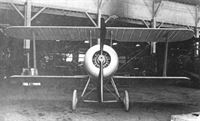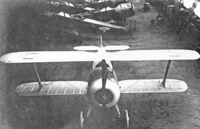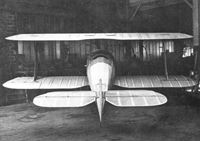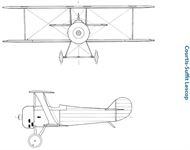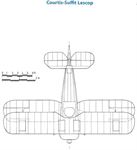J.Davilla, A.Soltan French Aircraft of the First World War (Flying Machines)
Courtois-Suffit Lescop
Courtois-Suffit Lescop C1
This aircraft is of historical significance as it was one of the first in the world to feature leading edge flaps. It was designed by Roger Courtois-Suffit and Capitaine Lescop. It has been described as being experimental, but French records show that it was intended to meet the C1 specification.
It is strange that an aircraft with such an advanced feature would have an outdated rotary engine, the 160-hp Gnome 9Nc that was also used by the SPAD 15, Nieuport 28 and Morane Saulnier 27 and 28. A more powerful development of the C.S.L.1 with a 250-hp Clerget 11E engine was to follow when that engine became available.
The C.S.L.1 was a small single-bay biplane. Its most impressive feature was the hinged leading edge flaps fitted to the lower wings and the tailplane. On the wings, these flaps were 1.3 m in span and 0.18 m in chord and were hinged along the forward spar. They were constructed of plywood and the hinges of the flaps were covered with fabric. There was a hinged portion which spanned the full length of the tailplane and was 0.15 meters in chord. Their setting was controlled from the cockpit. The upper wing did not feature leading edge flaps, and ailerons were fitted to the lower wings only. The fuselage was fully faired and the engine was housed in a cowling of broad chord. The landing gear had two wheels; each was mounted on a half-axle pivoted at the mid-point of the spreader bars.
The aircraft was built by the S.A.I.B. (Societe Anonyme d'Applications Industrielles du Bois) at its factory in Paris. Construction began in October 1917 and the C.S.L.1 was completed and undergoing testing by 1 May 1918. However, since the Gnome Monosoupape 9N was not available, a 140-hp Clerget 9Bf was fitted.
It is not known how successful the C.S.L.1 or its leading edge flaps were. It is known that the aircraft was not selected for production. In fact, none of the planes with the Gnome 9Nc was selected for service.
C.S.L. C1 Single-Seat Fighter with 140-hp Clerget 9Bf
Span 7.80 m; height 2.70 m; wing area 19 sq. m
Empty weight 470 kg; loaded 760 kg
Maximum speed: 220 km/h at sea level (provisional); climb to 4,000 m in 16 minutes; endurance 2.5 hours
Two built
C.S.L. C1 Single-Seat Fighter with 200-hp Clerget 11E (Estimated Performance)
Span 7.80 m; height 2.70 m; wing area 19 sq. m
Maximum speed: 240 km/h at sea level (provisional); climb to 4,000 m in 14 minutes
Project only
Courtois-Suffit Lescop Fighter with Clerget Engine
This aircraft was to have been a refinement of the C.S.L.1 (which was fitted with a 140-hp Clerget to undergo tests, pending the availability of a more powerful engine). While the C.S.L.1 was undergoing tests, development of the more powerful version was continuing. This aircraft was to have had equal-span wings with square tips. This new plane was also to be temporarily fitted with a 150-hp Clerget engine that would be nearly covered by an immense cone de penetration. The 150-hp Clerget was eventually to be replaced by the 300-hp Clerget 9Bf then under development. However, work on the Clerget 9Bf was never completed, and it appears that the second C.S.L. fighter was never built. This may have been due to the engine problems or because of difficulties with the new C.S.L. itself.
Показать полностью
W.Green, G.Swanborough The Complete Book of Fighters
COURTOIS-SUFFIT-LESCOP C.S.L.1 France
Designed by Roger Courtois-Suffit in collaboration with Capitaine Lescop, the C.S.L.1 single-seat fighter was flown for the first time in January 1918, having been constructed by the SAIB (Societe Anonyme d'Applications Industrielles du Bois) concern. The C.S.L.1 was, significantly, one of the first (if not the first) aircraft to feature leading-edge wing flaps, these being fitted to the lower mainplanes and elevated or depressed through a limited range of movement. The leading edge of the tailplane was also hinged. Intended for the 200 hp Clerget 11E eleven-cylinder rotary or, failing that, the 160 hp Gnome Monosoupape 9Nc nine-cylinder rotary, the C.S.L.1 was in fact fitted with the 140 hp Clerget 9Bf nine-cylinder rotary. A second prototype was to have been fitted with the 200 hp unit, but it is doubtful if this was completed. The following data are estimated for the C.S.L.1 with the 200 hp engine.
Max speed, 149 mph (240 km/h) at sea level.
Time to 13,125 ft (4 000 m), 14 min.
Endurance, 2.5 hrs.
Empty weight, 1,080 lb (490 kg).
Loaded weight, 1,720 lb (780 kg).
Span, 25 ft 7 in (7,80 m).
Wing area 204.5 sq ft (19,0 m2).
Показать полностью
C.Owers French Warplanes of WWI. Volume 1: Fighters (A Centennial Perspective on Great War Airplanes 43)
The Courtois-Suffit Lescop
The Courtois-Suffit Lescop scout was an experimental aircraft that was designed by Roger Courtois-Suffit and Capitaine Lescop to meet the French C1 specification (Fighter single seat). Construction was undertaken by the S.A.I.B. (Societe Anonyme d’Applications Industrielles du Bois) of 49 Rue St, Blaise, Paris. The most innovative feature of the machine was that the aircraft featured leading edge flaps, this being one of the first, if not the first time these had been fitted to an aeroplane.
The British Aviation Commission sent preliminary details of the experimental machine to RFC HQ on 10 October 1917. The machine had variable incidence for the leading edge of the bottom planes and the leading edge of the tailplane. Ailerons are being fitted to the bottom plane only, and the portion of the leading edge which is variable is the same length as the ailerons, viz:- 1 m. 300.
The French Section Technique are very interested in this experiment, which is intended to give a large range of speed near the ground. They estimate that the lowest speed will be about 87 k.p.h.
The variable leading edges are arranged so that they can be set in any desired position from the pilot’s seat.
The construction of this machine has only just been started ... The engine will be a 200 h.p. Clerget if one is available, otherwise a Monosoupape Gnome will be tried.
Construction began in October 1917, the US Army reporting on 23 October that the GNOME MONOSOUPAPE is also being installed in a Courtais-Suffit-Loscop. The British report on French Experimental Aeroplanes for November 1917, recorded that a 165-hp Monosoupape CSL was under construction and that a 250 Clerget biplane was being studied. Both had "Variable wing incidence for leading edges of bottom and tailplanes." Construction took a long time. A report in January 1918 stated that the machine was almost finished and was expected to be ready by the middle of the month with a Gn 9NC (160) engine. Testing was being undertaken by 1 May 1918, with a 140-hp Clerget 9Bf installed as the proposed Gnome Monosoupape 9Nc was not available. No trial results are known. The machine was not selected for series manufacture.
A conventional constructed biplane of wooden girder with fabric covering, the C.S.L. 1 emerged as a neat single bay biplane featuring "I" style interplane struts. A report by the British Maj J.C.P. Sewell on 24 April 1918, referred to the struts adopted for the COURTOIS-SUFFIT experimental machine (in designing which M. Bechereau is supposed to have helped) have adopted a single interplane strut similar to that of the German Roland 2-seater. This strut is bolted into the planes in the thickness of which socket, wire strainers and so on are completely concealed, greatly diminishing head resistance.
The struts were faired out at the top and bottom to connect with the front and rear spars. Similar struts were mounted at the fuselage. They were similar to those of the Sopwith triplane as they ran inside the fuselage longerons. A small strut ran from the upper longeron to the upper wing front spar. There were no control surfaces on the upper wing. The ailerons on the lower wing were operated Nieuport fashion by torque tubes.
The fuselage was faired out by formers and stringers from the circular cross section at the engine to an oval cross-section towards the tail. The machine resembled the Hollywood Nieuport 28 conversions with I-struts. It was proposed to use the Nieuport 28 fighter's engine, the 160-hp Gnome Monosoupape 9Nc nine-cylinder rotary. Its most revolutionary feature, as mentioned above, was the moveable flaps on the leading edge of the lower wing. These were hinged to the forward main wing spar and were 1.3 m long and 0.18 m wide. The leading edge of the tailplane was also hinged. These flaps were controlled from the cockpit. S.A.I.B had built the Sopwith 1 1/2 Strutter under licence for the French Army and the undercarriage was a typical Sopwith type with each wheel on a half-axle pivoted at the centre of the spreader bars.
The aircraft had been predicted to have speeds of 240 to 87 km/hr with the 200-hp Clerget. With the available engine it would not have achieved anything like these figures. No test details of the machine are known.
It was proposed to improve the design and a new aircraft with equi-span wings with square tips was proposed. This was to have been powered by the 300-hp Clerget then under development. Until this engine became available a 150-hp Clerget would be fitted with a large cone de penetration for flight trials. It is not known if this model was constructed, but the proposed high powered Clerget engines were unsuccessful and not developed.
Courtois-Suffit Lescop Specifications
Source 1 2 3 3
Span, m 7.800 7.80 - -
Length, m 7.600 - - -
Height, m 2.700 2.70 - -
Chord, m 1.300 - - -
Gap, m 1.700 (approx) - - -
Empty Wt, kg 490 490 490 470
Load, kg 290 - - -
Military Load, kg - - 50 50
Total, kg 780 780 750 760
Wing Area, m2 19.000 19 19 19
Speed at 4,000 m - - 210 kph 220 kph
Climb to 4,000 m - - 14 min 16 min
Endurance in hrs - - 2.5 2.5
Engine - 200-hp Clerget 11E 200 Clerget 130 Clerget
1) Details with letter of British Aviation Commission, Paris, to HQ RFC and GHQ, 10.10.1917. TNA AIR 1/2391/228/11/140.
2) J.M. Bruce data.
3) Estimated performance. "Department of Aircraft Production, British Ministry of Munitions of War, Paris, Monthly Aeroplane Report. May 1st 1918. French Experimental Aeroplanes, Scouts and Fighters." Chart from TNA AIR1/1071/204/5/1639. RAF Museum, J.M. Bruce Collection Box 15.
Показать полностью




